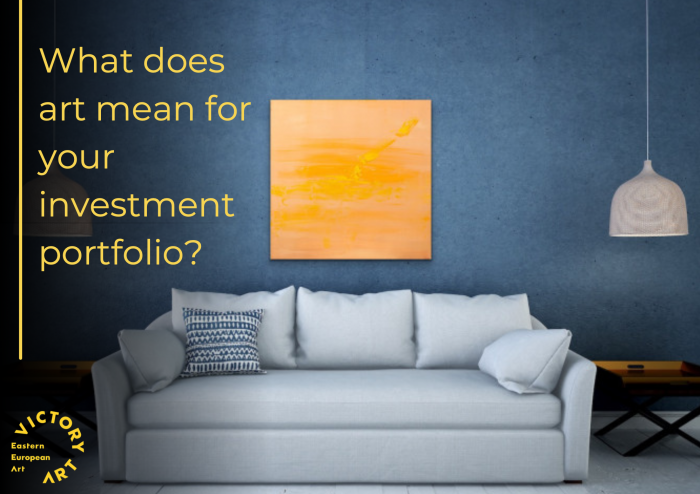MUST READ ART BLOGS
What Does Art Mean for Your Investment Portfolio?

The 2019 annual report by Art Basel and USB Global Art estimated the worldwide art sales to surpass $67 billion.
Why & How Art is a Good Investment Strategy?
The last few years have witnessed a boom in the art investment market. Such a boom has increased the focus towards art as an investment, just like stocks and bonds. Though art can increase in value, the market of art investing behaves differently compared to the regular financial market for stocks and bonds.
Investing in art is just like a long-term relationship, only suitable for patient investors. Though art is known to increase in value over time, the process takes a long time to mature. The normal lock-in period of any artwork is said to be about 10 years or more. Despite the increasing value of art over a period of time, the value of the art piece is highly dependent on the success of the artists’ career. The more the artist succeeds, the more the value of art and the return on investments increases. Just like how an artist cannot be successful overnight, investment returns can also not be created overnight. Hence most investors build assets in art to be passed down to their descendants.
Benefits of Art Investment
Reason 1
Value is not influenced by the Stock Market and it reduces risks
One of the major perks of investing in art is that the value of art does not rise and fall with the stock market. By now, many of us have seen the stock market rise and fall dramatically, and the effects of those changes. Most investors in their investment portfolio, besides stocks and shares, try to diversify their long-term wealth through art. Diversity in an investment portfolio helps reduce financial risks in case of financial hits. Diversification of portfolios has been growing in popularity, where it has been reported that 55% of wealth managers get requests from their clients to help invest in art and collectibles. Investing in art should always be considered a risk. As the value of the art is highly dependent on the career success of the artist. It is also commonly thought that the demise of the artist will automatically increase the value of the art. Though this may have its merits, it is important that at the time of his demise, the artist should have been considered a successful artist.
Reason 2
Tangibility of Art
One of the good things about art as an investment is its tangibility. The physical asset allows many investors to feel in control of their assets, which are otherwise managed by investment firms and SEC. It allows investors to feel assured, by being able to see and touch the art piece. Most investors often don’t get to see what happens to their money.
The tangibility of the art piece allows the investor to be responsible for its management, care, and storage. Though storage and care of art are also expensive. Most investors store the art pieces in cases that are temperature, sunlight, and humidity-controlled. Additionally, there are added costs such as insurance, authenticity certificates in the form of maintenance bills. You, as the owner, are solely responsible for maintaining the quality of the painting.
Also, if it is known in the neighborhood that you hang expensive artworks on your house walls, you might want to invest in a quality security system for the house.
Reason 3
Aesthetic Value over Financial Value
One of the basic principles to remember while investing in art is that firstly, invest in art only if you enjoy art. Aesthetic pleasures first, financial pleasure second. Secondly, don’t invest anything in art that you cannot afford to lose. Those with a passion for art and aesthetics will find investing in art very rewarding. Though art should only be a part of the whole portfolio, rounding out other investments.
On average, art returns 7.6 percent to investors each year, according to Artprice. Historically, the Standard & Poor's 500 index delivers an average annual return of 9.8 percent.
Check out our article, Benefits of Investing in Art, to learn more!Challenges of Investing in Art
Challenge 1: Barrier of knowledge
One of the biggest barriers to art investing is knowledge. If you are looking at art investment, then it is most commonly advised to take a few months to prepare and adequately inform yourself of the basics of art before purchasing a piece. The knowledge needs to be gained through not just reading, but also visiting your local galleries, art schools, and museums.
Challenge 2: Non-liquid asset
While investing in art, it is also important to remember that art is a non-liquid or illiquid asset, which means that it is not easy to sell and convert into cash right away. The sale of an art piece can take months at least.While investing in art, it is also important to remember that art is a non-liquid or illiquid asset, which means that it is not easy to sell and convert into cash right away. The sale of an art piece can take months at least.
Challenge 3: Not in the eye of the beholder
Unfortunately, when investing in art, - beauty does not lie in the eye of the beholder. The markets hold an objective claim over its value. Hence, there is not much room for emotional attachment in art investment. So even if you like an artwork, it is not necessarily going to be a good investment.
Challenge 4: Not a regulated investment
One of the biggest disadvantages, especially with high valued art pieces, is that art is not a regulated investment. In case there is fraud or replication of the art, the investors are on their own, with little support from the authorities or the law. There are no regulations to fall back on for any compensation.
Four years ago a painting believed to have been Leonardo Da Vinci’s work sold for a record of $450 million. But 60 years prior the very same painting was said to be the work of Leonardo’s followers and sold for a mere $60 at an auction.
Things to Consider Before Investing
Despite art being popular in the investment community, for most well-rounded portfolios, art only takes a small fraction of the entire portfolio. Despite the continuous increase in value, the possibility of large payouts from art itself is still too low.
The value of the artwork is highly dependent on an artists’ reputation, which makes it rather difficult to determine the true value of the artwork.
There is also no guarantee that the price you paid for the artwork will automatically increase in the next few years. Some skyrocket upon the passing of the artist, as the artist can no longer create more, therefore creating a scarcity of his work. Educating oneself before purchasing is the single best chance you have at achieving success with investing in art.
It is also important to invest in a professional appraisal before you buy art and to get insurance for high-valued art pieces.
Check out our article, Things to Consider Before Investing in Art, to learn more!
Some of the Other Options
Other Options for Art Investment-Art mutual funds are another option for investing in art, with a lower barrier to entry.
-Masterworks where you don't own artwork, but instead buy shares of painting.
-Another plus point: it is designed for novice art investors. Maecenas is another option just like masterworks.
Other Resources for Art Investment
-Artnet and Sotheby’s, to get a sense of what is happening in the art business - Magnus app provides up to date pricing information
-Saatchi online gallery for buying, as well as browsing
A Great Investment Strategy
This report has emphasized the valuable nature of art investment, its benefits, things to consider, and provided a few suggestions to consider before investing in art, and making the best out of your investment.
By investing in art, most investors diversify and reduce the risks that are often associated with the financial markets. Art investment helps reduce the impact of financial hits on an investment portfolio, as the art market's valuations are not dependent on the stock market. Also, art valuations are not dependent on which piece the investor finds beautiful, one has to remember there is no room for emotions while investing in Art. Art value is highly dependent on the artist's successful career.
So now, are you up for the challenge of diving into the art investment world?
If you want to know, even more, check our more detailed guide on how to buy art for yourself and for your office. We are always here to help you to find the right artwork, you can book an appointment with us, and remember, enjoy yourself while in the process!
CHECK OUT OUR BEST BLOGS

.webp)

.webp)
.webp)
.webp)
.webp)
.webp)









.jpg)